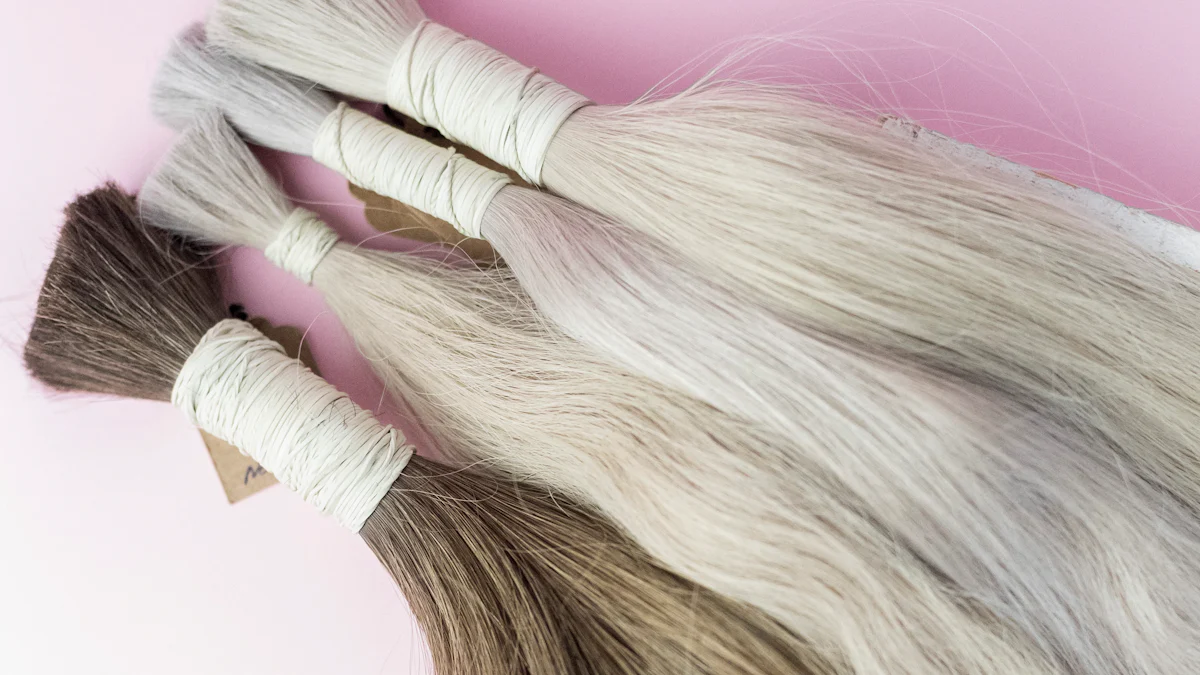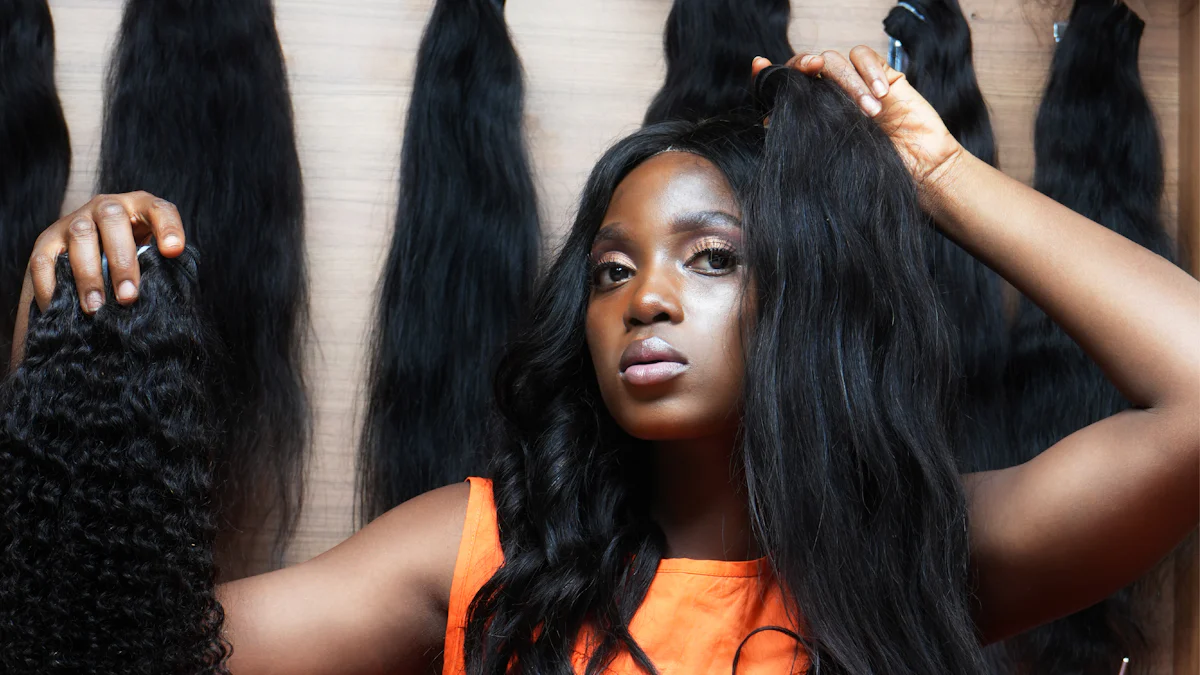Step-by-Step Guide to Styling Straight Lace Front Wigs with Baby Hair

Lace front wigs offer a magical transformation. These wigs create the illusion of natural hair growth from your entire hairline. Imagine the confidence boost when no one can tell you're wearing a wig. Straight lace front wigs provide a sleek, polished look that suits any occasion. However, achieving that flawless style requires the right information. Without proper guidance, even the best wig can look unnatural. Luvmeforyou understands this and aims to help you master the art of wig styling. Whether you prefer straight styles or short curly lace front wigs, the right techniques make all the difference.
Understanding Lace Front Wigs
What Is a Lace Front Wig?
A Lace Front Wig features a sheer lace panel along the front hairline. This design allows for a natural-looking hairline. The lace blends seamlessly with your skin, creating the illusion of hair growing directly from your scalp.
Types of Lace Wigs
The market offers various types of Lace Front wigs. These wigs differ in cap construction, lace color, and length. Some popular types include:
-
Full Lace Wigs: These wigs have lace throughout the entire cap, allowing for versatile styling options.
-
360 Lace Wigs: Lace runs around the perimeter of the wig, offering a natural look from all angles.
-
Front Lace Wigs: Only the front portion has lace, making these wigs more affordable while still providing a natural hairline.
Features of Lace Front Wigs
Lace Front Wigs come with several standout features. The lace material is lightweight and breathable, ensuring comfort during wear. Hand-tied baby hairs around the edges enhance realism. The wigs often come pre-plucked, reducing the need for additional customization.
Benefits of Lace Front Wigs
Versatility in Styling
Lace Front Wigs offer unmatched versatility. You can part the hair in any direction. Create various hairstyles, from sleek ponytails to intricate braids. The wigs adapt to your styling preferences effortlessly.
Realism in Appearance
The primary appeal of a Lace Front Wig lies in its realistic appearance. The sheer lace mimics your natural scalp. Baby hairs add to the authenticity. No one will guess you are wearing a wig.
Hair Protection
Wearing a Lace Front Wig protects your natural hair. The wig acts as a barrier against environmental damage. Frequent styling and heat exposure won’t harm your real hair. Enjoy different looks without compromising hair health.
Tools and Materials Needed
Essential Tools
Wig Cap
A wig cap serves as the foundation for your wig. It keeps your natural hair flat and secure. This helps create a smooth surface for the wig to sit on. Choose a cap that matches your skin tone for a seamless look.
Adjustable Elastic Band
An adjustable elastic band ensures your wig stays in place. This band provides extra security, especially during windy days. Attach the band to the inside of the wig for a snug fit. Adjust the tightness to your comfort level.
Wig Glue (if applicable)
Wig glue offers a strong hold for lace front wigs. Apply the glue along your hairline to secure the lace. Make sure to use a skin-safe adhesive. Test a small area first to avoid allergic reactions.
Styling Products
Edge Control Gel
Edge control gel helps you create sleek baby hairs. Apply a small amount to the hairline. Use a toothbrush or small brush to smooth the hairs. The gel keeps the baby hairs in place all day.
Hair Mousse
Hair mousse adds volume and texture to your wig. Apply the mousse to damp hair. Use your fingers to distribute it evenly. This product helps create a fuller look without weighing down the hair.
Small Tooth Comb
A small tooth comb is essential for detangling and styling. Use the comb to part the hair and make precise sections. This tool also helps create defined baby hairs. Keep the comb clean to avoid product buildup.
Preparing the Wig

Washing and Conditioning
Choosing the Right Products
Select high-quality shampoo and conditioner for your wig. Opt for sulfate-free products to maintain the wig's integrity. Look for moisturizing formulas to keep the hair soft and manageable. Avoid heavy oils that can weigh down the wig.
Proper Washing Technique
Fill a basin with lukewarm water. Add a small amount of shampoo. Submerge the wig and gently swish it around. Use your fingers to work the shampoo through the strands. Rinse thoroughly with cool water. Apply conditioner and let it sit for a few minutes. Rinse again with cool water. Pat the wig dry with a towel. Avoid wringing or twisting the hair.
Drying and Detangling
Air Drying vs. Blow Drying
Air drying preserves the wig's texture and longevity. Place the wig on a wig stand in a well-ventilated area. Allow it to dry naturally. For quicker results, use a blow dryer on a low heat setting. Keep the dryer at a safe distance to avoid heat damage.
Detangling Tips
Use a wide-tooth comb for detangling. Start from the ends and work your way up to the roots. Hold the hair near the base to prevent pulling. Apply a leave-in conditioner for added slip. Detangle in small sections for better control. Avoid using brushes that can cause breakage.
Creating Baby Hair

Sectioning the Hairline
Identifying Baby Hair Areas
To create baby hairs, start by identifying the areas along the hairline where baby hairs naturally occur. Focus on the temples and forehead. These spots usually have finer hair that can be styled into baby hairs. Luvmeforyou recommends using a mirror with good lighting. This helps you see the finer details of your lace front wigs.
Using a Rat Tail Comb
A rat tail comb is essential for sectioning the hair. Use the pointed end to part small sections along the hairline. This tool helps separate baby hairs from the rest of the wig. Gently pull out the baby hairs you want to style. Keep the sections thin for a natural look.
Trimming Baby Hair
Proper Scissors Technique
Trimming baby hairs requires precision. Use small, sharp scissors. Hold the hair between your fingers and cut at an angle. This technique creates a softer, more natural edge. Avoid cutting too much at once. Small snips work best to achieve the perfect baby hairs.
Length Considerations
Consider the length of your baby hairs carefully. Too long can look unnatural. Too short may not lay flat. Aim for about half an inch. This length allows for easy styling. Luvmeforyou suggests experimenting with different lengths. Find what works best for your brand-new lace front wig.
Styling Baby Hair
Applying Edge Control Gel
Edge control gel is crucial for styling baby hairs. Apply a small amount to the edges. Use your fingers to smooth the gel onto the hair. This product keeps the baby hairs in place all day. Luvmeforyou offers high-quality gels that provide a strong hold without flaking.
Using a Small Tooth Comb
A small tooth comb helps you shape the baby hairs. Use the comb to create gentle swoops and curves. This technique adds a stylish touch to your lace front wigs. For a more dramatic look, try baby hair swirls. Comb baby hairs flat for a sleek finish.
Setting the Style
Setting the style ensures longevity. After applying gel and shaping the baby hairs, tie a scarf around your hair. Leave it on for about 10 minutes. This step secures the edges and sets the style. Mayvenn Experts recommend this method for a polished look. Luvmeforyou products make this process easy and effective.
Advanced Styling Techniques
Heat Styling
Using a Flat Iron
Flat irons transform straight lace front wigs into sleek masterpieces. Start by setting the flat iron to the lowest heat. Gradually increase the temperature if necessary. Always avoid exceeding the recommended heat for synthetic wigs. For human hair wigs, use a heat protectant spray. This step shields the hair from damage.
Divide the wig into small sections. Clip each section away to keep it organized. Place the flat iron close to the roots and glide it down to the ends. Repeat this process for each section. Ensure even heat distribution for a flawless finish. A smooth, shiny look will enhance the wig's natural appearance.
Heat Protection Tips
Heat protection is crucial for maintaining wig quality. Use a heat protectant spray before styling. This product forms a barrier against heat damage. Apply the spray evenly throughout the wig. Focus on the ends, as they are more prone to damage.
Avoid using high heat settings. Lower temperatures preserve the wig's integrity. Always start with the lowest setting and increase gradually. Never rush the process. Patience ensures a beautiful, long-lasting style. Regularly clean the flat iron to prevent product buildup. Clean tools provide better results and extend the life of your wig.
Adding Volume
Teasing Techniques
Teasing adds volume and texture to straight lace front wigs. Begin by sectioning the hair. Use a small tooth comb for precision. Hold a section of hair straight up. Insert the comb about halfway down the strand. Push the comb down towards the roots in short, quick motions. This action creates volume at the base.
Repeat the teasing process for each section. Focus on areas where you want more volume. The crown and sides often benefit from extra lift. After teasing, gently smooth the top layer of hair. This step hides the teased sections and creates a polished look. Avoid over-teasing to prevent tangles and breakage.
Using Hair Mousse
Hair mousse offers an easy way to add volume. Apply mousse to damp hair for best results. Dispense a small amount into your palm. Rub your hands together to distribute the product. Work the mousse through the wig from roots to ends.
Use your fingers to lift and scrunch the hair. This technique enhances volume and texture. Allow the wig to air dry or use a blow dryer on a low setting. The mousse helps the hair maintain its shape and fullness. For added lift, focus on the roots when applying the mousse. Enjoy a voluminous, bouncy style that lasts all day.
Maintaining the Style
Daily Care Tips
Brushing and Combing
Daily care keeps your wig looking fresh. Use a wide-tooth comb or a wig brush. Start from the ends and work your way up to the roots. This method prevents breakage and maintains the wig's integrity. Gentle strokes keep the hair smooth and tangle-free. Avoid using regular brushes that can cause damage.
Avoiding Tangles
Tangles ruin the look of your wig. Prevent them by brushing regularly. Apply a leave-in conditioner like Beautimark’s Leave-in Conditioner. This product adds moisture and makes detangling easier. Use a detangler spray for stubborn knots. Always handle the wig with care to avoid unnecessary stress on the fibers.
Long-Term Maintenance
Washing Frequency
Regular washing extends the life of your wig. Use a mild shampoo and conditioner made specifically for wigs. Wash your wig every 10-15 wears. Fill a basin with lukewarm water and add shampoo. Gently swish the wig in the water. Rinse thoroughly and apply conditioner. Let the conditioner sit for a few minutes before rinsing again. Pat the wig dry with a towel and let it air dry.
Storage Tips
Proper storage keeps your wig in top shape. Store your wig on a wig stand to maintain its form. Keep it in a cool, dry place away from direct sunlight. Use a silk or satin bag for extra protection. Avoid storing the wig in plastic bags that can trap moisture. Regular maintenance ensures your wig looks natural and lasts longer.
Styling straight lace front wigs with baby hair transforms your look. Follow the steps to achieve a natural and polished appearance. Experiment with different styles and techniques. Enjoy the versatility and convenience of lace front wigs. Remember, practice makes perfect. Embrace the journey and have fun with your new look.






















